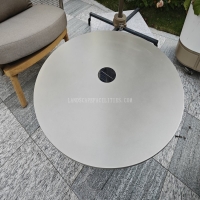Welcome to the website for landscape facilities products and knowledge.
How does the height of a landscape bar counter compare to traditional indoor bar counters, and what ergonomic factors influence this?
The height of a bar counter is a critical design choice that significantly impacts comfort and usability. While traditional indoor bars typically adhere to a standard height, landscape bar counters often deviate from this norm due to distinct functional and ergonomic requirements. Understanding this comparison is essential for creating a space that is both aesthetically pleasing and profoundly comfortable.
The most common height for a traditional indoor bar counter is 42 inches (107 cm). This measurement is not arbitrary; it is meticulously calculated to pair with standard 30-inch (76 cm) bar stools, providing approximately 12 inches of legroom for a seated adult. This setup promotes a relaxed posture with feet supported on the footrest and forearms resting comfortably on the countertop.
In contrast, landscape bar counters, designed for outdoor patios, decks, and gardens, frequently vary in height. While many mirror the indoor 42-inch standard, it is exceedingly common to find them slightly lower, around 40 or 41 inches, or even at a full-table height of 36 inches. Several ergonomic factors drive this variation.
Primary among these influencing factors is the nature of social interaction. Outdoor gatherings are often more active and mobile. A slightly lower counter can feel less formal and more inviting, encouraging guests to lean against it rather than remain statically seated. It can also accommodate a wider range of seating options, from taller stools to standard chairs, offering greater flexibility.
The type of activity is another crucial ergonomic consideration. Indoor bars are often optimized for focused drinking or dining. Outdoor "landscape" bars frequently serve as multi-functional spaces for cooking (e.g., as an outdoor kitchen bar), serving buffet-style meals, or simply placing drinks down while standing and mingling. A height that aligns comfortably with the user's natural standing elbow height (typically between 40-45 inches for an average person) reduces shoulder strain when preparing drinks or food.
Furthermore, the physical environment plays a role. An outdoor bar counter must often integrate with other fixed elements like built-in grills or countertops, which may have standardized heights between 36 to 38 inches. Maintaining a consistent height creates a seamless and visually cohesive cooking and serving area.
Ultimately, the optimal height is a balance between standardization and personalized ergonomics. The user's height is paramount; a counter that is too high forces awkward shoulder elevation, while one that is too low causes excessive bending of the back and neck. Whether indoors or out, the goal is to achieve a height where a person can stand comfortably with their arms bent at a 90-degree angle, resting their elbows on the surface without hunching or reaching.
Related search:

Recommendation
Outdoor stainless steel table with solar-powered ambient lighting feature - excellent design.